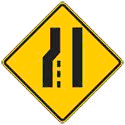
If you were driving and encountered one of those yellow traffic signs that indicated the road ahead narrowed from three to two lanes, would you: (a) ignore it, press the pedal to the metal and hope for the best, (b) wait until the very last moment and then cut in front of the next car inches before the guard barrier, or (c) start merging into traffic ahead of the road’s narrowing?
The hypothetical situation is analogous to the imminent FCC narrowbanding requirement that all public safety and business industrial land mobile radio systems operating in the 150-174 MHz and 421-512 MHz (VHF/UHF) radio bands must cease operating using 25 kHz efficiency technology, and begin operating using at least 12.5 kHz efficiency technology, by January 1, 2013.
Currently, the majority of UHF and VHF land mobile radio licensees operate using 25 kHz efficiency technology. The continued operation and proliferation of these wideband systems has led to congestion in the UHF and VHF frequency bands. Limited spectrum is available for system expansion or implementation of new systems. This congestion problem, if not remedied, can pose dire consequences for the integrity of existing public safety systems, as well as the future evolution of public safety systems.
Narrowbanding is an effort to ensure more efficient use of the VHF and UHF spectrum. The migration to 12.5 kHz efficiency technology will require licensees to operate more efficiently, either on narrower channel bandwidths or increased voice paths on existing channels. This will allow more users to take advantage of the additional channels that the FCC created within the same spectrum during the Refarming proceeding in the 1990s.
This policy should come as no surprise to licensees. The FCC first announced narrowbanding requirements in the mid-1990s, and in 2004, it set the January 1, 2013 deadline for migration to 12.5 kHz technology. In fact, many licensees have already completed the transition – that is, they have obeyed the “merging traffic” sign well in advance.
But many licensees still haven’t “merged” into the narrowband “lane,” and the January 1, 2013 deadline is approaching fast. On July 13, 2011, the Wirless Bureau, Public Safety Bureau, and Office of Engineering Technology released a public notice (DA 11-1189), found at www.fcc.gov/document/wireless-telecommunications-bureau-public-safety-and-homeland-security-bureau-and-office-en , as the FCC’s latest reminder of the deadline for licensees, frequency coordinators, equipment vendors, and other interested parties.
This public notice also provides guidance for licensees that may need to submit waiver requests because they face extraordinary circumstances in meeting the January 1, 2013 deadline. Specifically, the public notice sets out a number of discrete factors that will be relevant to the FCC in determining the merits of any request for waiver of the deadline. By providing this guidance publicly, our intent is to expedite the preparation and submission of waiver requests by licensees. The public notice also clearly stresses that requests for waivers of the narrowbanding deadline will be subject to a high level of scrutiny under the waiver standard set forth in Section 1.925 of the Commission’s rules.
So, congratulations if you answered (c), to the pop traffic question. Like merging into traffic, narrowbanding requires licensees to plan ahead to avoid an accident. Failure for UHF and VHF licensees to narrowband can result in harmful interference to neighboring users, compromised operation of their own systems, and of course, potential forfeiture of license authorization as well as enforcement penalties.
More information about the narrowbanding can be found by accessing the Public Safety and Homeland Security Bureau’s webpage at https://transition.fcc.gov/pshs/public-safety-spectrum/narrowbanding.html.